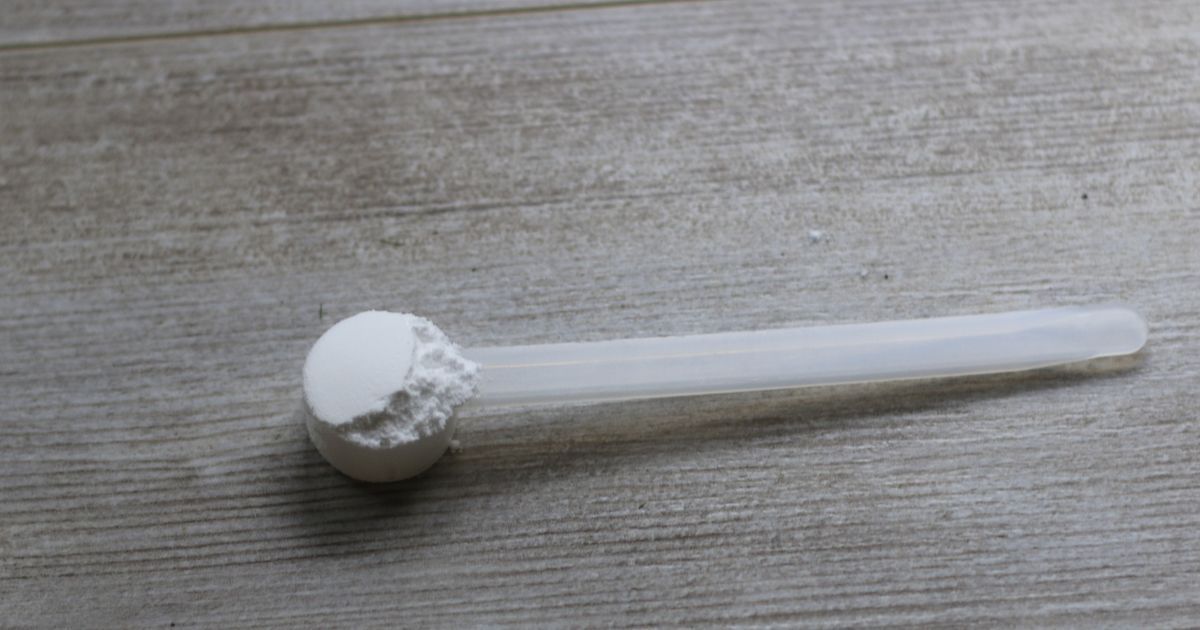
How Much Creatine Should I Take For Next-Level Fitness?
Ever wondered 'how much creatine should I take'? Our article breaks down the science-backed recommendations for the ideal creatine dosage.
Creatine, ever heard of it? If you're into fitness or have been exploring the world of supplements, chances are, you have.
It's a popular supplement used by athletes and fitness enthusiasts worldwide to enhance muscle strength and improve exercise performance. But before we dive into how much of it you should be taking, let's first understand what creatine actually is.
What is Creatine?
Creatine is synthesized by your body using three amino acids: L-arginine, glycine, and L-methionine. This synthesis primarily occurs in the liver, with a lesser contribution from the kidneys and pancreas.
In essence, taking creatine supplements increases your body's natural stores of phosphocreatine, which your body uses to produce ATP (adenosine triphosphate) - a high-energy molecule that provides the energy your muscles need to contract.
But here's the catch. While creatine can provide numerous benefits, it's crucial to take the right dosage.
Why? Because too little might not give you the desired effects, and too much can lead to unwanted side effects like stomach upset or muscle cramps. Hence, knowing the optimal dosage for your individual needs is key to reaping the full benefits of creatine.
Creatine HCL vs Creatine Monohydrate
You may have come across two major types of creatine: Creatine Hydrochloride (HCL) and Creatine Monohydrate. But what's the difference between these two? Which one is better for you? Let's break it down.
Creatine HCL
Creatine HCL is a newer form that's gaining popularity. It's essentially the same creatine molecule bound with hydrochloric acid. This makes it 38 times more soluble in water than creatine monohydrate, meaning it dissolves more easily and may have better absorption.
Creatine Monohydrate
Creatine Monohydrate is the most researched form of creatine and has been proven effective in improving power output, strength, and muscle mass. It works by increasing your muscles' phosphocreatine stores, allowing you to produce more ATP, a high-energy molecule, during exercise.
The Benefits
Both forms of creatine offer similar benefits, such as increased strength, improved high-intensity exercise performance, and enhanced muscle recovery. However, they differ slightly in their usage and effectiveness.
Creatine Monohydrate recommends doing a loading phase of around 20-25 grams per day for 5-7 days, followed by a maintenance phase of 3-5 grams per day. This ensures that your muscles are fully saturated with creatine, allowing you to reap the maximum benefits.
Creatine HCL, however, does not require a loading phase due to its high solubility. This means you can start with a lower dose, which can be beneficial for those who experience stomach discomfort or bloating with higher doses of creatine monohydrate.
Which One is Better?
So, which one should you choose? The answer ultimately depends on your individual needs and preferences.
If you want a tried-and-tested supplement with extensive research backing its effectiveness, Creatine Monohydrate is the way to go.
However, if you're looking for a supplement that doesn't require loading and may cause less stomach discomfort, Creatine HCL could be a suitable option. Just bear in mind that it's a bit more expensive and doesn't have as much research supporting its benefits as creatine monohydrate supplementation.
Regardless of which form you choose, remember that consistency is key when it comes to reaping the benefits of creatine.
The Standard Dosage Recommendation

Now, let's talk numbers. According to a study by the Journal of the International Society of Sports Nutrition, the standard dosage recommendation for creatine is 3-5 grams per day.
Yes, you read that right. Just a teaspoon of creatine powder is all you need to fuel your workouts and boost your performance.
Lower, daily dosages of creatine supplementation (i.e. 3-5 g/day) are effective for increasing intramuscular creatine stores, muscle accretion and muscle performance/recovery.
The study also shows that you do not need to ‘load’ creatine to obtain optimal results.
- It found that there was little to no benefit in taking 20-25 grams per day for the first week of creatine supplementation.
- But if you are a larger athlete your optimal dosage could be anywhere between 5-10 grams a day.
But why is this amount sufficient for most people? Well, our bodies naturally produce about 1-2 grams of creatine per day.
- By supplementing with an additional 3-5 grams, we're effectively doubling or even tripling our creatine stores.
- This increase is usually enough to enhance muscle strength, increase lean body mass, and help the muscles recover more quickly during exercise.
Understanding Creatine Loading
Beyond the standard dosage, there's another approach we may have hinted at earlier - the creatine loading phase.
The idea behind creatine loading is to rapidly maximize your muscle stores of creatine. This way, you can experience the benefits of creatine faster.
- According to Healthline.com, this method can cause your muscle cells to inflate, leading to muscle growth and increased performance in high-intensity activities.
- However, creatine loading isn't without its drawbacks. The sudden increase in dosage can sometimes lead to digestive issues, such as bloating or diarrhea.
- Additionally, some research suggests that not everyone responds to creatine loading, particularly those who already have high natural creatine stores in their muscles.
In the end, whether you choose to do a loading phase or stick to the standard dosage depends on your personal goals, tolerance, and how quickly you want to see results. As with any supplement, it's always best to listen to your body and adjust your dosage as needed.
Creatine for Athletic Performance

Now, if you're an athlete or someone involved in high-intensity sports, you might be wondering: "Does the standard dosage still apply to me?"
Well, the answer is - it depends. Athletes often have a higher demand for creatine due to their intense training routines.
You might be thinking, "That's a huge jump from the standard dosage!" But don't worry, there's science to back it up.
- Several studies have found that high-dose creatine supplementation can enhance athletic performance, particularly in activities requiring short bursts of intense effort like sprinting or weightlifting. [source]
However, it's crucial to remember that these recommendations are not one-size-fits-all. Factors such as your exercise intensity, training volume, and even diet can influence how much creatine you should take.
Determining Your Ideal Creatine Dosage
So, how can you find the 'sweet spot' for your creatine dosage? One way is by calculating your dosage based on body weight.
Naked Nutrition recommends taking about .03 grams of creatine per kilogram of body weight per day. For example, if you weigh 70 kilograms (about 154 pounds), your ideal creatine dosage would be around 2.1 grams per day.
But remember, everyone is unique. Some people might need more or less than 5 grams depending on factors like muscle mass, exercise routine, and dietary intake.
It's always best to start with a lower dose and gradually increase it while monitoring your body's response.
Creatine Usage for Muscle Building

Lastly, let's talk about creatine for muscle building. If your primary goal is to bulk up, you might want to consider a different approach to creatine supplementation.
Everyday Health suggests taking 20 grams of creatine per day for a limited time, followed by a 3- to 5-gram daily dose afterward. This approach combines the benefits of creatine loading (rapid increase in muscle stores) and maintenance dosing (sustained benefits over time).
In the end, finding the right creatine dosage is a personal journey. It's about understanding your body, your goals, and how this powerful supplement can help you reach them.
Always listen to your body and adjust your dosage as needed. And of course, don't forget to consult with a healthcare professional before starting any new supplement regimen.
The Remarkable Benefits of Creatine

1. Enhanced Muscle Strength and Size
Creatine is most well-known for its ability to increase muscle mass and strength. It boosts the formation of proteins that create new muscle fibers, helping you bulk up more effectively. Plus, creatine draws water into your muscle cells, making them look fuller and larger.
2. Improved Exercise Performance
When it comes to high-intensity workouts, creatine is your best friend. It increases the body's store of phosphocreatine, which is used to produce ATP, the molecule your body uses for energy during exercise. This means longer, harder workouts, and ultimately, better results.
3. Speedier Muscle Recovery
Ever struggled with post-workout soreness? Creatine can help with that. Research suggests that creatine supplementation can reduce muscle inflammation and soreness after intense exercise, helping you bounce back faster.
4. Boosted Brain Health
Creatine isn't just for muscles - it's also vital for brain health. It supports the brain’s energy reserves, improving cognition and reducing mental fatigue. Studies have shown that it may be beneficial in neurological diseases like Alzheimer's, Parkinson's, and Huntington's disease.
5. Enhanced Bone Healing
Preliminary research suggests that creatine might improve bone density, promoting bone healing and increasing the cellular activity involved in bone repair. This makes it a promising supplement for those concerned about bone health.
Safety Considerations When Taking Creatine
Before we wrap this up, let's talk safety. Just like any other supplement, creatine should be taken responsibly. So, what does that mean?
While creatine is generally considered safe for most people, it can cause some side effects, especially when taken in high doses.
These can include stomach discomfort, bloating, diarrhea, and muscle cramps. To avoid these, it's always best to start with a lower dosage and gradually increase it, allowing your body to adjust.
Also, remember that long-term use of creatine requires some caution. Although research suggests creatine can be used safely for up to five years, it's still essential to monitor your body's response and consult with a healthcare professional regularly.
Frequently Asked Questions
Can you take 10g of creatine a day?
Yes, you can, especially if you're an athlete or involved in high-intensity sports. However, it's best to start with a lower dose and gradually increase it while monitoring your body's response.
How much creatine should I take for best results?
The "best" dosage varies from person to person. However, a good starting point is the standard dosage recommendation of 3-5 grams per day.
How much creatine should I take a day to build muscle?
For muscle building, consider taking 20 grams of creatine per day for a limited time, followed by a 3- to 5-gram daily dose afterward.
How much creatine is normal per day?
The standard creatine intake recommendation for most people is 3-5 grams per day. However, your ideal dosage may vary depending on factors like body weight, exercise routine, and dietary intake.
Can you take too much creatine?
Absolutely, consuming excessive amounts of creatine can lead to gastrointestinal discomfort and other side effects like weight gain in the form of water retention. The amount considered "too much" varies per individual, but it's generally recommended to start with a lower dose and gradually increase it.
Bottom Line
So, there you have it. We've explored what creatine is, the standard dosage recommendations, the concept of creatine loading, and how athletes or those looking to build muscle might require different dosages. We also discussed how to calculate your ideal creatine dosage and the safety considerations you need to keep in mind.
But remember, everyone is unique. What works best for one person might not work as well for another. Therefore, it's crucial to listen to your body and find the creatine dosage that suits you best. And of course, always consult with a healthcare professional before starting any new supplement regimen.
Remember, your journey with creatine is just that - a journey. It's all about finding what works best for you and your body. Here's to your health and fitness success!
Recommended For You...





